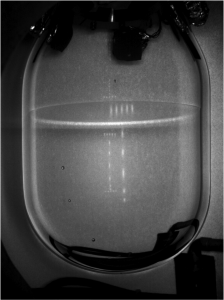- PICASSO: Project In Canada to Search for Supersymmtric Objects
- COUPP: Chicagoland Observatory for Underground Particle Physics
Current astrophysical observations suggest that we only understand what makes up about 4% of the universe, with the unknown 96% divided into two parts, dark energy and dark matter. Researchers at the Fermilab Center for Particle Astrophysics are trying to understand both of these components, and COUPP is part of the effort to detect dark matter. There is a class of theories predicting the existence of Weakly Interacting Massive Particles, or WIMPs, that could comprise a large part if not all of the dark matter in the universe. If they exist, these WIMPs might interact with nuclei in a terrestrial detector and be observed directly.
In a throwback to an earlier era of particle physics, COUPP uses stable room-temperature bubble chambers to search for WIMPs. A bubble chamber is filled with a fluid superheated above its boiling point where the deposition of a small amount of energy can nucleate the formation of an easily visible bubble. The fluid in COUPP is superheated CF3I, a fire-extinguishing agent and an optimal target for both spin-dependent and spin-independent WIMP couplings. At the moderate degrees of superheat necessary to detect low-energy nuclear recoils like those expected from WIMPs, this fluid exhibits a measured intrinsic rejection of 1010 for minimum-ionizing backgrounds like those produced in gamma-ray interactions, rendering the COUPP chamber effectively blind to the largest category of backgrounds in dark matter searches. Recent developments have resulted in the further rejection of alpha recoils using the acoustic signature of bubble formation, allowing for a jump in sensitivity to dark matter.
 COUPP has successfully tested the alpha rejection in a 4 kg chamber at the ~300 m.w.e. depth of the NuMI tunnel at Fermilab, and this chamber is being commissioned at SNOLAB during the summer and early fall of 2010. The NuMI data are already capable of setting the best limits on spin-dependent WIMP couplings, and underground running will further improve the sensitivity of the device.
COUPP has successfully tested the alpha rejection in a 4 kg chamber at the ~300 m.w.e. depth of the NuMI tunnel at Fermilab, and this chamber is being commissioned at SNOLAB during the summer and early fall of 2010. The NuMI data are already capable of setting the best limits on spin-dependent WIMP couplings, and underground running will further improve the sensitivity of the device.
In addition, the COUPP collaboration is currently testing a new 60 kg chamber in the same NuMI tunnel. The 60 kg chamber should exhibit an increase in sensitivity relative to the smaller chamber due to improved shielding and statistics, as well as a lower threshold. After being moved underground to SNOLAB before the summer of 2011, the 60 kg chamber will hopefully achieve world-leading sensitivities to both spin-dependent and spin-independent WIMP interactions.
Other goals of the COUPP collaboration include improving our understanding of the energy threshold for bubble nucleation using neutron sources at Argonne. In addition, we have been charged to assess the scalability of this technique to the deep-underground installation of a target mass of order one ton, using a number of different refrigerant targets immersed in a suitable shielding and leading to an exhaustive exploration of supersymmetric WIMP models.
Team Members
- Mike Crisler
- C. Eric Dahl
- Hugh Lippincott
- Erik Ramberg
- Andrew Sonnenshein










